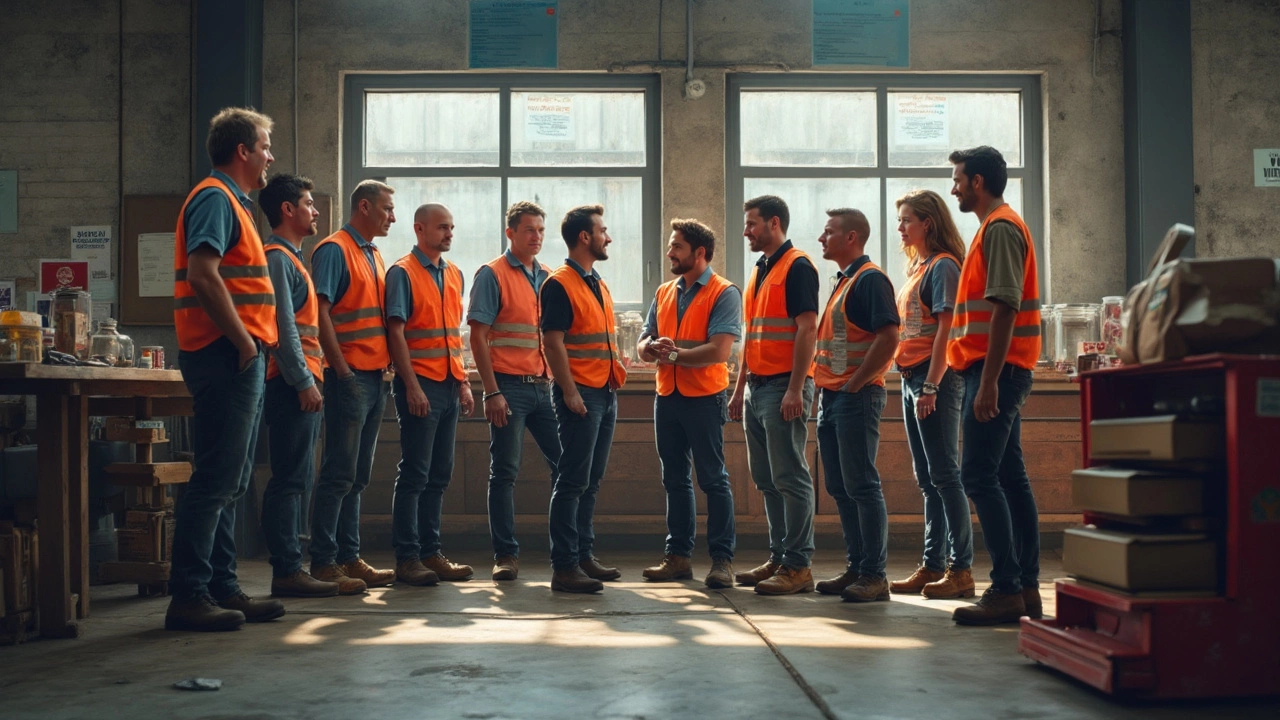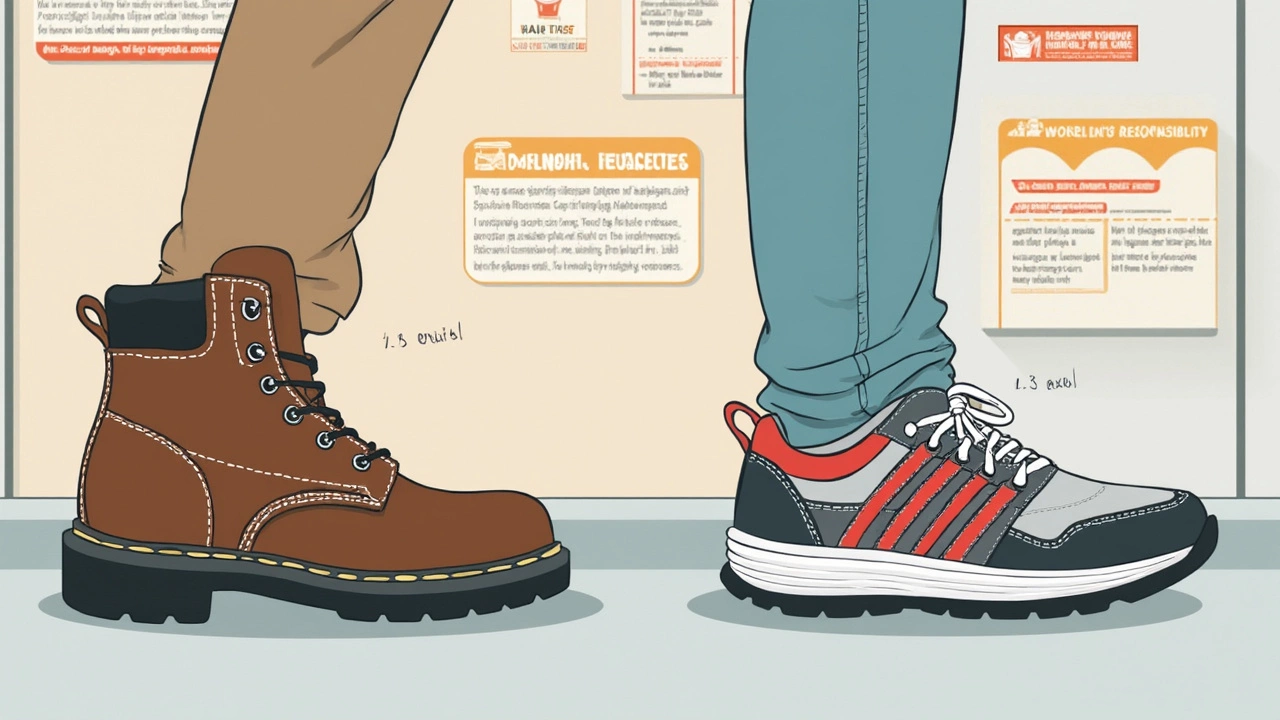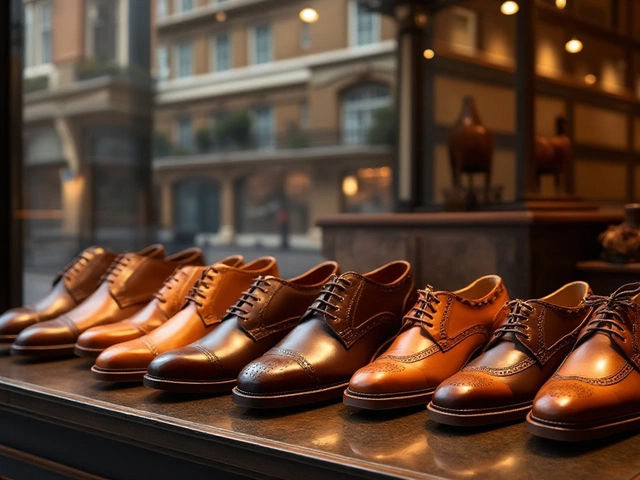Can I Refuse to Wear Safety Shoes at Work?

- Cleo Fairchild
- 11 May 2025
- 0 Comments
If you’ve ever groaned at the thought of another day in thick, clunky safety shoes, you’re not alone. Lots of people wonder if they really have to put them on—especially when their feet feel sore or the shoes just seem over the top for the job.
Here’s the deal: safety shoes aren’t just a random rule. They’re part of workplace safety laws in most countries, and bosses can get into serious trouble if they let someone skip out. In the UK, for example, the Health and Safety Executive lists safety footwear as personal protective equipment (PPE) and makes it pretty clear when it’s needed—think heavy items, slippery floors, or sharp things lying around.
Some jobs are strict about it, like warehouses and construction. Others, the rules might feel a little blurry. But if the risk is real, and your manager has supplied the shoes for a reason, refusing to wear them could mean way more than just an awkward chat in the break room.
- Why Safety Shoes Are Required
- What Happens If You Refuse
- When You Might Be Exempt
- Tips for Comfort and Compliance
Why Safety Shoes Are Required
If you’ve ever had a pallet skid across the floor or dropped a box on your toe, you know why workplaces get picky about safety shoes. These aren’t just ugly boots—there’s a reason laws insist on them. Employers are legally required to look out for employees’ safety, and a lot of injuries start with what’s going on at ground level.
The Health and Safety Executive (HSE) says,
“Each year there are thousands of foot injuries in the workplace, many of which could be prevented by wearing appropriate protective footwear.”That’s not just an empty line—foot injuries make up about 7% of all workplace injuries reported in the UK every year.
So what kind of stuff do safety shoes actually help with? Here’s what you’re protected from:
- Heavy objects dropping and crushing your toes (think tools, boxes, even machinery)
- Sharp items on the ground that could puncture your foot
- Slippery floors where you could easily lose your footing
- Chemicals or electrical hazards in specialized jobs
- Extreme heat or cold (especially on outdoor or factory sites)
Here’s a quick look at just how common these risks really are:
| Type of Incident | % of Workplace Foot Injuries |
|---|---|
| Crushing from dropped objects | 39% |
| Piercing from sharp items | 19% |
| Slips, trips, falls | 28% |
| Other (burns, chemicals, electrical) | 14% |
It’s not only about big construction sites either. Even in retail stockrooms or kitchens, people step on nails, slip on spills, or have things fall on them. There’s a solid reason why the rules cover a wide range of jobs, not just the super-dangerous-looking ones. And if you’re thinking, “My job seems pretty safe,” just know that workplace accidents rarely send a calendar invite before they show up.
What Happens If You Refuse
If you refuse to wear safety shoes when your job requires them, it’s not just your toes at risk—your job could be on the line too. Most workplaces treat this as ignoring a direct safety rule, not just a simple preference. Some companies have written policies that spell out the consequences, and they’re pretty strict about it.
Let’s break down what you’re facing if you say no to those work shoes:
- You could get a formal warning. Some companies start with this step to show they’re serious.
- Repeated refusals might lead to suspension without pay or even getting fired, especially in jobs where accidents are more likely.
- If you get hurt on the job and weren’t wearing safety shoes, you might not get full workers’ comp or sick pay, because insurers can turn around and say you didn’t follow the rules.
- Your company could get in trouble too. Health and safety officers do regular checks, and if someone isn’t wearing the right gear, the fines can be steep—sometimes thousands of pounds or dollars.
Here’s a quick look at what’s actually happened in real workplaces:
| Year | Incident | Consequence |
|---|---|---|
| 2023 | Warehouse worker refused safety shoes | Suspended, manager warned by HSE |
| 2022 | Food factory worker hurt foot skipping PPE | Reduced compensation, employer fined £5,000 |
| 2021 | Construction site audit found non-compliance | 2 workers fired, company received improvement notice |
So, refusing isn’t just about keeping your feet comfy—it can hit your wallet, your job, and your employer’s reputation. And don’t count on a manager just looking the other way; most companies care way too much about safety records to risk it.

When You Might Be Exempt
Here’s where things get interesting. Not everyone has to wear safety shoes all the time, even if your workplace has a general policy. There are a few situations when your boss might need to make an exception—or at least try to find another solution for you.
The most common reason is medical. If you’ve got certified foot issues—like bunions, plantar fasciitis, or trouble with swelling—a doctor’s note can go a long way. Your company can’t legally ignore serious health needs. By UK law, for example, if standard safety footwear makes an existing medical condition worse, your employer has to consider alternatives. Think protective overshoes, custom-fitted safety boots, or even shoe allowances to find a better fit.
Another thing that can come into play is religious or cultural reasons. Sometimes, workplace safety has to be balanced with someone’s right to dress a certain way for religious practice. This doesn’t mean you’re automatically off the hook, but your employer should try to work with you to find something that works for both sides—like specialty covers or different styles.
Here’s a quick look at what makes someone likely to qualify for an exemption:
- Valid medical documentation showing a health issue aggravated by safety shoes
- Proof of religious or cultural practices conflicting with standard footwear
- No real risk of foot injury present at your specific station—confirmed by a proper risk assessment
Super interesting: a 2023 survey from the Institute of Occupational Safety and Health found that about 7% of UK workers were issued alternative protective footwear due to medical reasons. That might seem small, but it means your request isn’t out of the ordinary.
| Reason for Exemption | Percentage of Employees |
|---|---|
| Medical | 7% |
| Religious/Cultural | 2% |
| Risk Not Present | 4% |
If you think you qualify, talk honestly with your manager or HR. Bring proof. Sometimes, it takes a couple tries to get the right footwear, and it’s normal to go through a bit of trial and error. If they refuse without a good reason, you’ve got the right to ask for a risk assessment or get advice from a health and safety rep.
Tips for Comfort and Compliance
If you’re stuck with safety shoes and dreading every step, you’re not powerless. A lot of workers struggle the first week, but some tweaks can make life easier.
- Try out different brands and styles. Most workplaces let you choose from a list of approved options. Lightweight models with breathable mesh can feel way better, especially if you’re on your feet for hours.
- Swap the insoles. The factory ones are usually thin and not built for actual comfort. Memory foam or gel inserts (under $20 at most stores) can totally change how your shoes feel after lunch.
- Wear proper socks. Thick, moisture-wicking socks limit blisters and sweat. Cotton isn’t always best; synthetic blends are good at keeping feet dry.
- Break them in at home. Don’t wait until your shift to start wearing them. Break them in gradually around the house so you’re not limping by noon your first day.
- Let your manager know about real problems. If you get bad foot pain, rashes, or your shoes don’t fit right, tell someone. Your workplace might be required to supply shoes that actually fit, not just any random pair that sort-of works.
One overlooked fact: under UK law, your employer has to provide PPE like safety shoes for free and ensure they fit you properly. They should also offer replacements if the shoes wear out or become uncomfortable.
Check this quick comparison table so you know some features to look for if you get a choice:
| Feature | Why It Matters | What to Look For |
|---|---|---|
| Toe protection | Protects from falling objects | Steel cap, composite, or aluminium |
| Slip-resistance | Helps prevent slips on slick floors | Rubber soles with grip patterns |
| Breathability | Stops sweat, reduces blisters | Mesh panels, perforations |
| Weight | Lighter shoes mean less fatigue | Composite materials over steel |
| Fit | Pain-free shifts and lower injury risk | Wide sizing, arch support, adjustable laces |
Your feet work hard—don’t be shy about asking for a swap if your work shoes just aren’t right. Small fixes can make a massive difference in your day. And remember, safety isn’t just some rule; it’s about you coming home with all ten toes happy.


